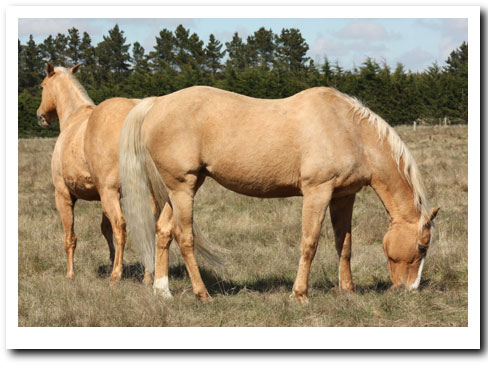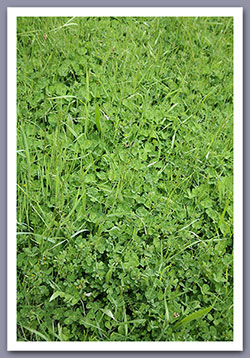Changing to Safer Pasture
I believe by correctly feeding the flora in the hind-gut with high fibre, low carbohydrate diets (predominantly mature suitable grass, hay, chaffs, beets) instead of high carbohydrate, low fibre diets (too much young, green grass, molassed feeds and grains) and ensuring correct mineral balances from conception onwards with quality Vitamin & Mineral mixes, that we will have healthy useful horses well into their twenties and early thirties instead of the high incidences of arthritic, Cushing's afflicted horses in their teens that we are seeing now.
Spraying out Paddocks

If your pasture is full of rye-grass & clover you will need to spray out twice, over two consecutive Autumns. The following autumn spray out again and re-sow with your permanent mix of horse-friendly grasses. The proportions of the various grasses in your mix will depend on your soil type and how free-draining it is. For instance Prairie grass does not like clay soils whilst Yorkshire Fog grows well in wetter areas.
|
Managing Brand New Pasture
If you have already resown or are planning to renovate your pastures, here is some important information:
1. We very rarely advocate completely spraying out and resowing pasture – only do this if you have solid rye and clover. If there is a mixture of grasses with clover then, as per the last few posts, a broad-leaf spray is all that will be needed.
2. If you are resowing new grasses it is very important to take into account what sort of horses you have and what their purpose is. In other words you may sow a different mix of horse-friendly grasses for Mum’s hack and the kid’s ponies to what you would if you were breeding sport or race horses. You will also have a slightly different mix according to your soil types, drainage and climate.
3. You need to factor in where to keep your horses over this whole process. Best not to expect to be able to graze this new grass for quite some time! Brand new grass (of any variety) is VERY potent and prone to mineral imbalances. You risk sudden onset of potentially serious metabolic problems until after you have done the following…
- Once the grass has established, you will need to either mow it or put some sheep over it (they are light and won’t trash it). The idea is to take the top off and cause the roots to strengthen up so that when horses do eventually graze it, they won’t pull it all out by the roots.
- Then take a cut of hay off it and WAIT until it has dried off before even thinking about grazing it.
4. Don’t be talked in to having fertilizer put in with the seeds! What the seeds need most is WATER.

The result of a paddock that was fertilised - it made the clover grow rampantly!
About Soil Tests
Herbage and soil test results can be quite different. For instance it is not uncommon for soils to be high in magnesium but the grass growing in that same soil may be low in magnesium.
In other words the soil test result does not tell you what nutrient value the horse is getting from eating the grass. It only tells you about levels in the soil.
Should You do a Soil Test?
If economics permit, it is a good idea to conduct a soil test to identify major mineral deficiencies and rectify them where possible. If economics do not permit as is the case for many horse owners especially those who do not own their own land, then it is not the end of the world. Just attend to your horse’s nutrition with top quality supplements, such as the Premium NZ Horse Minerals or the Supreme Vit & Min for Australia.
If you are going to conduct a soil test it is wise to do a comprehensive one rather than the standard one from the local farm store. You need to know whether your soil is deficient in any of the major minerals and what steps will be necessary to restore balance and biological activity for healthy grass growth.
Attending to your soil in this way will also minimise the incidence of pathogenic (harmful) bacteria, fungi and weeds that thrive in sour soil environments.
The whole process of improving the health of the soil is ongoing and will take years, so it is important to re-test your soil every couple of years to monitor the progress.
Success depends upon the interpretation of these soil tests:
Because most agricultural advisors have a ‘farmer’s viewpoint’ they will likely recommend that you apply nutrients or chemicals for the purpose of maximising grass growth. Remember, this is not what you want. Applying nitrogen, phosphates, potash, urea, or combinations like NPK is likely to be counterproductive, if not disastrous for the health and reproductive success of the stock forced to consume the grass grown in it.
Such applications are likely to cause a variety of issues, ranging from the comparatively mild effects of hyper-sensitivity (which causes difficulty with handling) or low conception rates, to serious life threatening conditions like laminitis, head-flicking, digestive upsets, colics, abortions, limb deformities and so on.
You need to have the soil test interpreted by someone who understands that the needs of
horses are completely different to the needs of commercial livestock.
 Calm Healthy Horses
Calm Healthy Horses